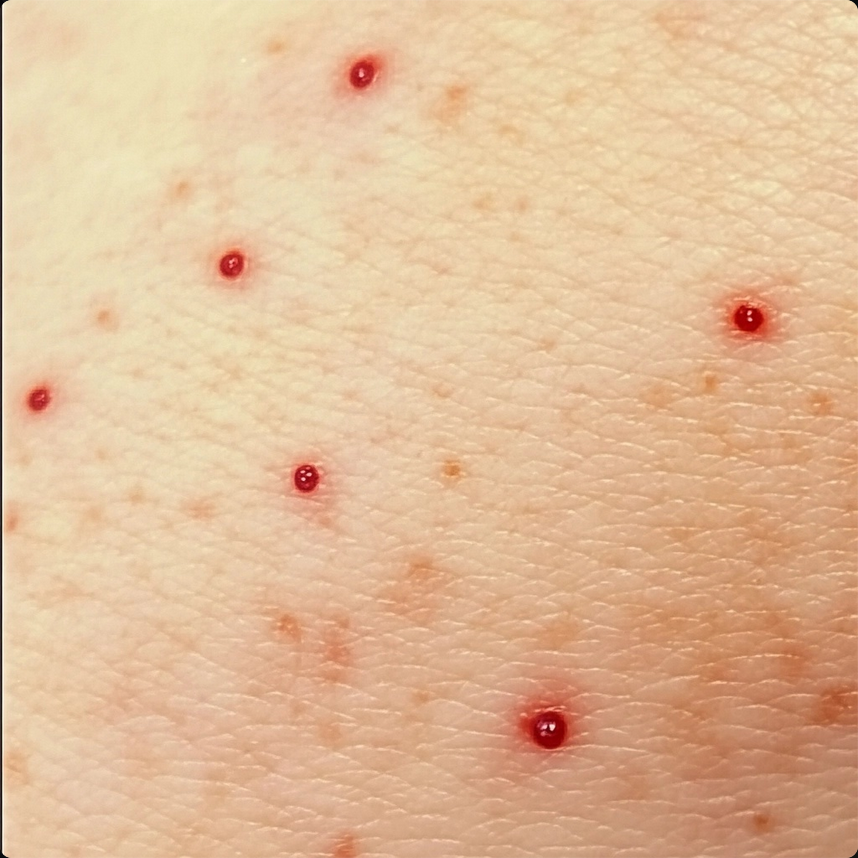What Red Spots on Your Skin Mean : Causes, Symptoms, and Solutions
Red spots on the skin can be alarming, but they often have varied causes ranging from harmless to more serious underlying health conditions. Some spots may clear up on their own, while others might require medical treatment. In this article, we explore potential causes, symptoms, and remedies for red spots, with an emphasis on healthy skincare, prevention strategies, and when to seek medical attention.
Common Causes of Red Spots on the Skin
- Petechiae (Tiny Red or Purple Spots)
- Caused by broken blood vessels (capillaries) under the skin.
- Often triggered by coughing, physical stress, or medications.
- These spots are usually harmless but, in rare cases, may indicate platelet disorders.
- When to see a doctor: If the spots increase in number or do not fade.
- Cherry Angiomas (Red Moles)
- Small, bright red spots caused by a buildup of blood vessels.
- Common in older adults and generally harmless.
- No treatment is usually necessary unless for cosmetic reasons.
- Heat Rash
- Occurs when sweat ducts become blocked, causing red, itchy bumps.
- Triggered by hot, humid weather or excessive sweating.
- Wear breathable clothing and stay cool to prevent outbreaks.
- Allergic Reactions
- Skin can develop red patches due to exposure to allergens such as food, medications, or insect bites.
- Symptoms include itchiness, swelling, and hives.
- Treat mild reactions with antihistamines or topical creams, but seek immediate medical care for severe reactions (anaphylaxis).
- Folliculitis
- An infection or inflammation of hair follicles, resulting in red, pus-filled bumps.
- Typically caused by bacteria or fungi.
- Proper hygiene and antibacterial creams can help prevent and treat folliculitis.
- Cellulitis
- A bacterial infection that makes the skin appear swollen, red, and warm to the touch.
- Requires immediate medical treatment with antibiotics to prevent complications.
- Impetigo
- A contagious skin infection, common in children, that creates red sores that ooze and form crusts.
- Early treatment with antibiotics prevents spreading.
- Vasculitis
- Inflammation of the blood vessels, which can cause red or purple patches.
- Linked to autoimmune diseases or infections.
- Infantile Hemangiomas (Red Bumps in Infants)
- Raised red birthmarks caused by overgrowth of blood vessels.
- Usually harmless but may require medical monitoring if they grow large.
Natural Remedies for Red Spots on the Skin
Incorporating natural remedies into your skincare routine can alleviate mild skin issues and prevent future outbreaks. These remedies promote hydrated, healthy skin and may complement medical treatments.
- Aloe Vera Gel
- Apply fresh aloe vera gel twice daily to soothe red spots.
- Leave it on for 15-20 minutes before rinsing.
- Coconut Oil
- Use organic coconut oil as a moisturizer for irritated areas.
- Apply overnight to maximize its anti-inflammatory properties.
- Dandelion Root Tea
- Dandelion root helps detoxify the body, which can reduce skin irritation.
- Boil dandelion root powder in water, strain, and drink daily.

When to See a Doctor
While many red spots are harmless, it's essential to seek medical advice if you notice:
- Changes in size, shape, or color.
- Spots that do not fade over time.
- Accompanying symptoms like fever, swelling, or pain.
- Recurrent outbreaks without a clear cause.
Nutrition Tips for Healthy Skin
Maintaining healthy skin involves more than just topical care. A balanced diet with plenty of fruits, vegetables, and healthy fats plays a vital role. Essential nutrients like vitamins A, C, E, and omega-3 fatty acids promote skin health and help prevent inflammation.
Prevention Strategies for Healthy Skin
- Hydration: Drink plenty of water daily to keep your skin hydrated.
- Sun Protection: Use sunscreen to prevent sun damage, which can aggravate skin issues.
- Skincare Routine: Cleanse your skin regularly with gentle, fragrance-free products.
- Avoid Allergens: Identify and avoid triggers that cause allergic reactions.
- Exercise Regularly: Physical activity promotes circulation and supports skin health.
Spreading Awareness for Healthier Skin
Sharing information about skin conditions helps raise awareness and encourages early treatment. If you found this article helpful, share it on social media to help your friends and family make informed decisions about their skin health.
Alt Image Text: "A close-up of a hand showing red spots, with healthcare tips for treatment and prevention in the background."
Final Thoughts: Prioritize Skin Health
While many red spots on the skin are harmless, others could indicate underlying health conditions that need medical attention. Understanding the cause behind these spots allows you to manage symptoms effectively and prevent future issues. Incorporate healthy skincare practices, follow a balanced diet, and consult with a healthcare professional when necessary to ensure your skin stays vibrant and healthy.
Remember, your skin health reflects your overall well-being. Make small, consistent changes to your routine to enjoy lasting benefits—because healthy skin is always in style.
